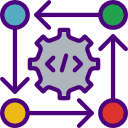No-code platforms have revolutionized digital transformation by enabling individuals and businesses to build powerful applications without traditional programming expertise. As technology continues to advance, innovative no-code solutions have emerged, offering ever-greater flexibility, rapid deployment, and streamlined workflows. This page explores the latest advancements in no-code platforms, highlighting crucial developments, integration capabilities, and future trends that empower users to achieve more with less coding knowledge.
Next Generation Automation in No-Code
Visual Workflow Builders
Visual workflow builders have become a cornerstone in the evolution of no-code platforms. By employing intuitive drag-and-drop interfaces, users can construct elaborate workflow automations that mirror real organizational processes—all without writing a single line of code. These builders support conditional logic, branching, and integration with external systems, giving non-technical staff the autonomy to create solutions tailored to their needs. The visual representation of workflows not only simplifies design but also aids in troubleshooting and optimizing automation, resulting in faster deployment and higher business agility.
AI-Driven Automation
Artificial intelligence is now an integral part of cutting-edge no-code solutions, powering automation with machine learning, natural language processing, and predictive analytics. Users can train models or configure AI algorithms within no-code environments to carry out advanced tasks such as data enrichment, sentiment analysis, or intelligent routing. This democratization of AI within no-code ecosystems means users from diverse backgrounds can leverage smart automation, eliminating repetitive work, delivering enhanced insights, and ultimately improving customer experiences while reducing operational costs.
Cross-Platform Orchestration
Modern businesses require automation that crosses boundaries between software environments, devices, and cloud services. Innovative no-code platforms facilitate cross-platform orchestration by providing connectors and APIs that seamlessly integrate different tools. Users can design workflows that, for example, trigger emails from CRM events, update databases, or synchronize files with cloud storage without specialized integration skills. This connectivity ensures that automation flows do not operate in silos but interact with the broader technology stack, driving comprehensive efficiency gains.
Advanced Integration Capabilities
Efficient API management is a defining feature of advanced no-code platforms. Users can connect to virtually any app or service by leveraging built-in or customizable APIs, opening the door to limitless automation possibilities. These platforms simplify authentication, data mapping, and error handling, making complex integrations accessible to non-developers. As a result, organizations achieve greater interoperability, reduce integration costs, and swiftly respond to evolving business requirements—all from a no-code interface.

Enhancing Security and Governance
Role-Based Access Controls
No-code platforms now feature advanced role-based access controls, allowing administrators to fine-tune permissions across teams and projects. Users can limit who can view, edit, or deploy specific applications, ensuring that sensitive data and critical processes are handled only by authorized individuals. This granular control supports regulatory compliance and reduces the risk of inadvertent or malicious changes, making no-code a viable option even for industries with stringent security mandates.
Built-In Compliance Frameworks
With regulations like GDPR, HIPAA, and SOC 2 shaping how organizations handle data, no-code solutions have evolved to include compliance-focused tools and templates. These built-in frameworks help users configure applications that meet legal and industry requirements out of the box. Automated audit trails, data encryption options, and secure data storage features are now standard, empowering organizations to innovate quickly without compromising on compliance or risking costly penalties.
Centralized Monitoring and Reporting
Monitoring and reporting are critical to managing the health and security of no-code applications at scale. Modern platforms provide centralized dashboards where administrators can view usage metrics, audit logs, and security alerts in real time. This visibility streamlines troubleshooting, supports proactive risk management, and informs governance strategies. As organizations deploy more no-code solutions, centralized monitoring ensures that oversight and control keep pace with rapid digital growth.
Join our mailing list
